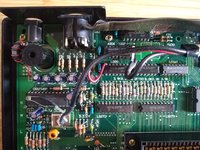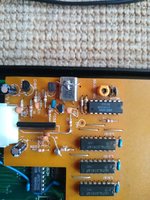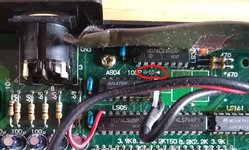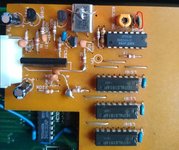joethearachnid
n00b

- Joined
- Apr 2, 2023
- Posts
- 9
Hi all,
I got a fabulous deal (relatively) a few months back on a supposedly broken AES that I think the seller just had a broken PSU for, anyway it's been working great and the case is in good condition externally, although internally some of the screw posts are broken and the cartridge flaps are missing. I'm working on some 3D printed solutions for these so all good.
The system is a 19xxx NEO-AES board with a stock US bios and FCC sticker which makes me happy, but it's one of the units that was modified with a PL241S daughterboard to clean up the composite video. I've heard that whilst these improve the composite video, the RGB suffers so it's best to remove it if you're using RGB. Today I decided to recap the console and replaced all the video output caps and resistors with the correct values and also to remove the PLL and move its clock crystal to the mainboard, as I've been told that's all that's required.
However, with the clock crystal on the mainboard I was only getting garbled video and static sound so I assume that the clock wasn't working at all. I moved the crystal back and reinstalled the PLL and it's working again, so the issue isn't with the capacitors or resistors I've changed. I'm running video through a PAL Trinitron that accepts PAL, NTSC, composite, S-video, RGB and just deals with it so I'm pretty sure it's not a compatibility issue.
Is there another step I've missed somewhere with the clock swap? I only removed the PLL connections to the mainboard, nothing else. Any thoughts welcome!
I got a fabulous deal (relatively) a few months back on a supposedly broken AES that I think the seller just had a broken PSU for, anyway it's been working great and the case is in good condition externally, although internally some of the screw posts are broken and the cartridge flaps are missing. I'm working on some 3D printed solutions for these so all good.
The system is a 19xxx NEO-AES board with a stock US bios and FCC sticker which makes me happy, but it's one of the units that was modified with a PL241S daughterboard to clean up the composite video. I've heard that whilst these improve the composite video, the RGB suffers so it's best to remove it if you're using RGB. Today I decided to recap the console and replaced all the video output caps and resistors with the correct values and also to remove the PLL and move its clock crystal to the mainboard, as I've been told that's all that's required.
However, with the clock crystal on the mainboard I was only getting garbled video and static sound so I assume that the clock wasn't working at all. I moved the crystal back and reinstalled the PLL and it's working again, so the issue isn't with the capacitors or resistors I've changed. I'm running video through a PAL Trinitron that accepts PAL, NTSC, composite, S-video, RGB and just deals with it so I'm pretty sure it's not a compatibility issue.
Is there another step I've missed somewhere with the clock swap? I only removed the PLL connections to the mainboard, nothing else. Any thoughts welcome!







